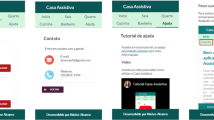Abstract
Smart home environments have evolved to the point where everyday objects and devices at home can be networked to give the inhabitants new means to control them. Familiar information appliances can be used as user interfaces (UIs) to home functions to achieve a more convenient user experience. This paper reports an ethnographic study of smart home usability and living experience. The purpose of the research was to evaluate three UIs—a PC, a media terminal, and a mobile phone—for smart home environments. The results show two main types of activity patterns, pattern control and instant control, which require different UI solutions. The results suggest that a PC can act as a central unit to control functions for activity patterns that can be planned and determined in advance. The mobile phone, on the other hand, is well suited for instant control. The mobile phone turned out to be the primary and most frequently used UI during the 6-month trial period in the smart apartment.



Similar content being viewed by others
References
Abowd GD, Mynatt E (2000) Charting past, present, and future research in ubiquitous computing. ACM Trans Comput Hum Interact (TOCHI) 7(1):29–58
Beyer H, Holtzblatt K (1998) Contextual design: defining customer-centered systems. Academic Press, San Francisco, California
Brumitt B, Cadiz JJ (2001) “Let there be light”: examining interfaces for homes of the future. In: Proceedings of the conference on human–computer interaction (INTERACT 2001), Tokyo, Japan, July 2001. IOS Press, Amsterdam
Crabtree A, Hemmings T, Rodden T (2002) Pattern-based support for interactive design in domestic settings. In: Proceedings of the conference on designing interactive systems: processes, practices, and techniques, London, UK, June 2002
Crowley JL, Coutez, J, Bérard F (2000) Perceptual user interfaces: things that see. Commun ACM 43(3):54–64
Hindus D, Mainwaring SD, Leduc N, Hagström A, Bayley O (2001) Casablanca: designing social communication devices for the home. In: Proceedings of the SIGCHI 2001 conference on human factors in computing systems, Seattle, Washington, March/April 2001
Koskela T (2003) Smart home usability and living experience. MSc thesis, Tampere University of Technology
Maxwell K (2001) The maturation of HCI: moving beyond usability towards holistic interaction. In: Carroll J (ed) Human–computer Interaction in the new millennium. ACM Press, Boston, Massachusetts, pp 191–209
Mozer M (1999) An intelligent environment must be adaptive. IEEE Intell Syst Appl 14(2):11–13
Mynatt ED, Rowan J, Craighill S, Jacobs A (2001) Digital family portraits: supporting peace of mind for extended family members. In: Proceedings of the SIGCHI 2001 conference on human factors in computing systems, Seattle, Washington, March/April 2001
Preece J, Rogers Y, Sharp H (2002) Interaction design: beyond human–computer interaction. Wiley, New York
Rodden T, Benford S (2003). The evolution of buildings and implications for the design of ubiquitous domestic environments. In: Proceedings of the SIGCHI 2003 conference on human factors in computing systems, Fort Lauderdale, Florida
van de Sluis R, Eggen B, Jansen J, Kohar H (2001) User interface for an in-home environment. In: Proceedings of the conference on human–computer interaction (INTERACT 2001), Tokyo, Japan, July 2001. IOS Press, Amsterdam
Venkatesh A, Nicosia F (1997) New technologies for the home: development of a theoretical model for household adoption and use. In: Brucks M, MacInnis D (eds) Advances in consumer research, vol. XIV. Association for Consumer Research, Provo, Utah, pp 552–558
Weiser M (1994) The world is not a desktop. Interactions, vol 1. ACM Press, New York, pp 7–8
Yates A, Etzioni O, Weld D (2003) A reliable natural language interface to household appliances. In: Proceedings of the international conference on intelligent user interfaces (IUI 2003), Miami, Florida, January 2003
Acknowledgements
This research was carried out in co-operation with Nokia, Pikosystems, Tekes, and TUT’s Institute of Electronics. We thank all the participants for their support. In addition, thanks are due to Tommi Mikkonen and Inka Vilpola for their valuable comments.
Author information
Authors and Affiliations
Corresponding author
Rights and permissions
About this article
Cite this article
Koskela, T., Väänänen-Vainio-Mattila, K. Evolution towards smart home environments: empirical evaluation of three user interfaces. Pers Ubiquit Comput 8, 234–240 (2004). https://doi.org/10.1007/s00779-004-0283-x
Received:
Accepted:
Published:
Issue Date:
DOI: https://doi.org/10.1007/s00779-004-0283-x




